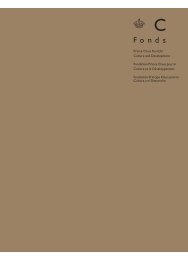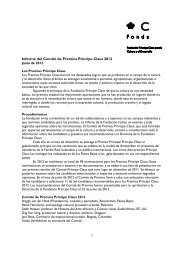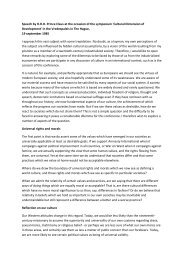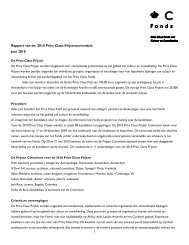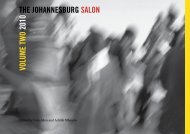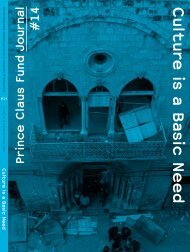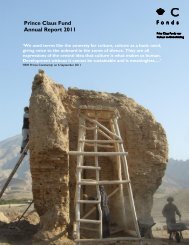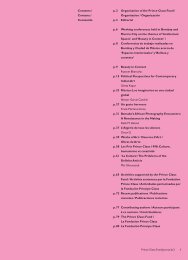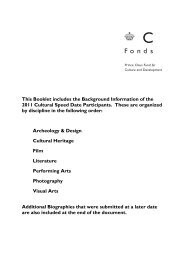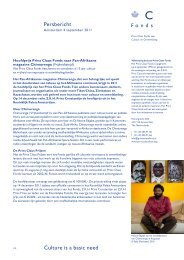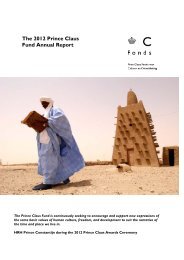3 summer 2011 - Prince Claus Fund
3 summer 2011 - Prince Claus Fund
3 summer 2011 - Prince Claus Fund
- No tags were found...
Create successful ePaper yourself
Turn your PDF publications into a flip-book with our unique Google optimized e-Paper software.
give cause for repetition and ‘ritual’ evident in Caribbean arts and other culturalexpressions. These in turn give to the peoples of the region a sense of placeeven while they operate on the margin and find cause to question the principles.It is such paradox that gets encapsulated in the festival arts of the Caribbeanof which the pre-Lenten carnival is only one – albeit an iconic and dominant onein contemporary Caribbean life. It is used for conventional means of release,recreation and celebration alongside the attraction for tourists whose dollar(or euro) is vital to Caribbean economic survival in these globalised times. TheCaribbean Diaspora is itself a preserver of the phenomenon and so Brooklyn (NewYork), Boston and Miami, Toronto, (Canada) and Notting Hill (London) have becomecentres of the Caribbean Carnival in the diasporic West Indian battle for spaceand the preservation of identity among migrants residing in hostile host communitieswhich are struggling to save themselves from ‘contaminants’ deemed alien totheir hallowed homogenous selves.Back in the Caribbean other festival arts exist as part of that same process ofself-discovery and the creation of a unifying space that bridges the gaps withina society produced by centuries of differentiation based on place of origin,race, skin colour, class, gender and the more modern differentials of politicalaffiliation and sexual orientation. So there is the more recent Crop Over festivalart drawing on the historical experience of sugar-cane slavery in Barbados whichhas revived and developed a time-worn celebration into a major contemporarycalendar event of national observance. Hosay serves to bring into the loop ofCaribbean cultural life the [East] Indians who entered Caribbean society afterthe abolition of slavery as indentured labourers but fully equipped with acultural memory of Islam and Hinduism. The cross-fertilisation process naturallycontinued and the paradoxes of new encounters increased the heightening anddeepening of the enriched mixture, even while tension plagued social and politicalrelations. Hosay is one result of such contradictory omens threateninglydisintegrative but hopefully integrative. So the Afro-West Indians often do thedrumming, while the [East] Indians do the dancing in this festival art. And the[East] Indian ‘spirit’ in Jamaican pocomania speaks to the early integration ofAsian indentured labour into ex-slave syncretised religious rituals, themselvesproducts of cross-fertilisation.There are, of course, other festival arts equivalent to the pre-Lenten carnivaland which have ancestral pedigree rooted in the clash/encounter of Europe andAfrica on foreign soil in the Americas. It is called Masquerade in the LeewardIslands. It has long existed in Jamaica, Belize and the Bahamas under the name ofJonkonnu and in Bermuda as Gombay. The Dia de Reyes of Cuba which has been thetarget of anthropological study by Fernando Ortiz of Cuba, the Rara of Haiti andother minor complexes of collective cultural assertion bear testimony to thesuccess and tenacity of the process and the products.They all represent the essence of Caribbean cultural life since they are, asRoberto Gonzalez-Echevarria has said of Cuban artistic manifestations: ‘Theindiscriminate fusion of European, American classical and popular elements, as wellas of instruments of the most varied origins…produce a new music, a newconglomerate in which there need be no synthesis. The heterogeneous…is also anabandonment of the notions of origins, to which none of the sundry elementsneed remain faithful, instead it is in itself an origin, a new beginning – it isalready the future contained in the beginning’.So, according to Edouard Glissant, the Martinican writer, the Caribbean has nomyth of origin, only a myth of relations – relations of this, that and the otherand all in one grand pepper pot, transforming the Caribbean cultural persona intothe part-African, part-European, part-Asian, part-Native American, but totallyCaribbean phenomenon already cited. The Native American component remainsdespite a history of ethnocide affecting Caribs and Tainos. The fact of cultural69 · <strong>Prince</strong> <strong>Claus</strong> <strong>Fund</strong> Reader #3 · Summer <strong>2011</strong>



